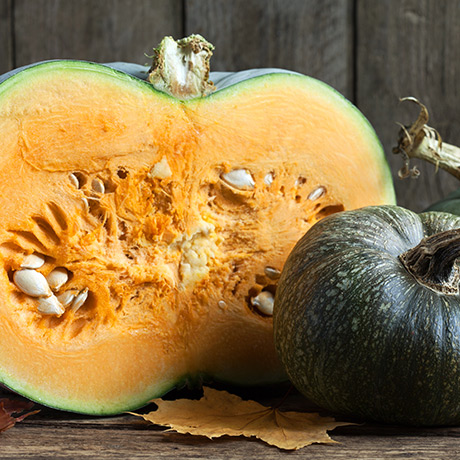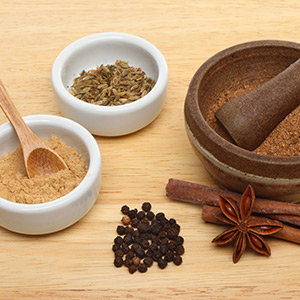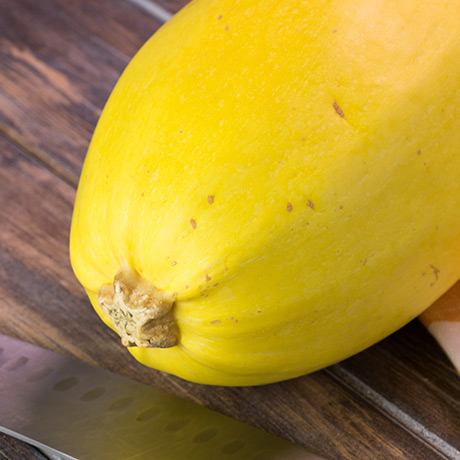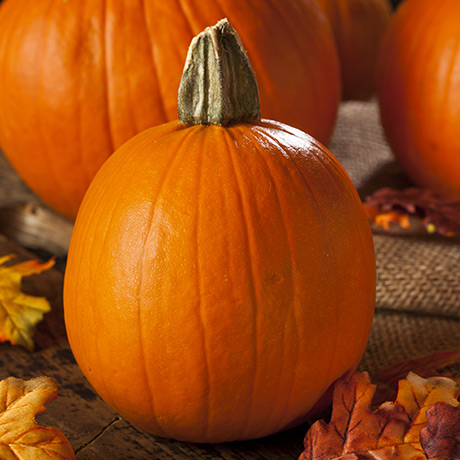- Strawberries
- Cook With Apples
- Grapes
- Grapefruit
- Lemons
- Cabbage
- Asparagus
- All About Bulb Vegetables
- All About Cruciferous Vegetables
- Squash
- All About Root Vegetables
- The Gift of Spice
- Thyme
- Basil
- Raspberries
- All About Tuber Vegetables
- Marjoram / Oregano
- Lemongrass / Citronella
- All Our Fruits, Vegetables and Fresh Herbs
- All About Exotic Fruits
- All About Legumes
- Cooking Pears: Three Inspirational Methods
Squash

These tasty, round cucurbits are not just beautiful, they are also delicious and good for you. On average, they contain almost as much immune-boosting Vitamin A per serving as carrots!
Summer squash
Summer squash are picked when they are quite young, long before they are ripe. They are more tender-tasting than winter squash and more easily bruised. Contrary to winter squash, summer squash can be eaten raw.
Zucchini

Zucchini is the best-known summer squash. It’s soft and looks like similar to a cucumber with thin, smooth skin, which can be yellow or green and sometimes streaked. Zucchini flesh has high water content and little taste. Zucchini are best when they measure between 15-20 cm. Zucchini flowers are also edible and are delicious fried.
Globe squash

There are two different varieties of globe squash: the green Emerald Globe and the yellow Champagne Globe. They are round and about the size of an orange. The Emerald is speckled green while the Champagne is yellow. Both have white flesh that is firmer than that of the zucchini.
Crookneck squash

Both the skin and flesh of the crookneck squash are yellow. It has a thin, curved swan-like neck and is covered with tiny bumps. Its flesh is mildly sweet and watery. The thin, tender skin of the crookneck squash doesn't need to be peeled in many recipes.
Patty pan squash

The patty pan squash is a rare summer squash. It is round with a curved edge similar to a soup spoon or a mushroom cap. Its skin is smooth and hard. The firm, sweet flesh can be white or bright yellow depending on the variety. The patty pan squash is not as tender as the zucchini, but should be treated similarly.
Culinary tips and advice
- Summer squash should be firm and tender with shiny unblemished skin. A bright peel means that the squash is young and flavourful. The squash should be heavy for its size.
- It can be served whole, halved, peeled, diced, julienned or sliced. If served raw, it can be eaten by itself, added to salads, or used in appetizers or sandwiches. If cooked, summer squash can be used in soups, ratatouille and cheese sauces. It can also be fried or puréed and used in cakes and biscuits. It is excellent braised, sautéed, roasted, steamed, grilled or stuffed.
- To stuff, slice in two lengthwise, scoop out the centre and fill with garnish. To stuff patty pan squash, slice off the top stem, scoop out centre and fill.
- Summer squash is excellent sautéed with dill, mint, butter, lemon and garlic.
Expert Tip
Summer squash cooks quickly, so it should be added at the end of the cooking process.
Availability
Summer squash is available year-round in the produce section of your local Metro supermarket.
Nutritional value
Summer squash provide energy and are rich in fibre, vitamins A and B and potassium.
Storage life
Summer squash can be refrigerated for a few days in a perforated plastic bag.
Winter squash
Winter squash are harvested in the fall and can be kept through the winter. They typically have crooked shapes and hard, bumpy skins.
Buttercup squash

Buttercup squash is small, round and has dense, non-fibrous orange flesh that’s sweet and tender. It’s skin is dark green with greyish markings. Because of its shape, it’s perfect for stuffing.
Butternut squash

Butternut squash has a bulb-like shape and smooth, pale yellowish skin. It’s flesh is orange, tender and sweet. It’s commonly made into soup, side dishes and added to risottos, pastas, curries and casseroles.
Turban squash

This vibrant vegetable gets its namesake due to its turban-like shape. Its base is mainly orange, while its top section has more green and white markings. The turban squash has firm, sweet, floury flesh great for stews, couscous and curries. It can also be stuffed and cooked in its shell.
Acorn (pepper) squash

Acorn squash have distinct ridges that run from the top of its roundish, green shell to the bottom. When cooked, its pale orange flesh has a peppery hazelnut flavour. It’s commonly sliced and baked, or stuffed.
Spaghetti squash

Spaghetti squash can be round or oval, with creamy white or yellow skin. Green spaghetti squash should be avoided, as it hasn’t fully ripened. Spaghetti squash has a very fibrous flesh and delicious, sweet flavour. When cooked, the flesh can be scraped out with a fork to make spaghetti strands.
Stripetti squash

This hearty vegetable can be green with yellow, longitudinal markings or yellow with green, longitudinal markings. Related to the spaghetti squash, the stripetti can be prepared in the same way to make spaghetti-like strands using a fork. It has a mild, fresh flavour.
Orangetti squash

The orangetti squash has orange skin and very sweet flesh. Similar to spaghetti squash, the orangetti has fibrous flesh that can be pulled into strands. But be careful: it cooks more quickly!
Dumpling squash

The great thing about the dumpling squash is that it doesn’t require peeling! Whether it’s puréed, used in soup or cut into pieces for a recipe, dumpling squash retains the same texture. Its flavour is very sweet with hints of chestnut and hazelnut.
Pumpkin squash

The fall season would not be complete without delicious pumpkin treats. Its lovely orange flesh is sweet and fragrant, perfect for desserts, as well as curries and soups.
Culinary tips and advice
- The easiest ways to cook squash are steaming, oven-baking and microwaving. To test doneness, insert the blade of a knife into the flesh as you would with potatoes.
- To cook in the microwave oven, cut the squash in two or in four depending on size and remove seeds. Cover with plastic wrap making sure to lift one of the corners or place in a microwave plastic bag, then microwave on high for 10 to 15 minutes, until tender.
- To cook on the stovetop, cut the squash in two or in four depending on size and remove seeds. Peel or wait until it is cooked to remove the skin. Immerse in boiling water and cook for 10-20 minutes, until tender.1.• To cook on the stovetop, cut the squash in two or in four depending on size and remove seeds. Peel or wait until it is cooked to remove the skin. Immerse in boiling water and cook for 10-20 minutes, until tender.
- To bake in the oven, cut the squash in two or four depending on size and remove the seeds. Baste with a little butter or oil and add seasoning. Cook in a 180º C (350º F) oven for 30 to 60 minutes, depending on the size of the pieces and the variety of squash.
Nutritional value
Winter squash are rich in fibre and an excellent source of vitamins A and C. They’re also a good source of Vitamin B6, copper, manganese and potassium.
Availability
Some winter squash are available year-round in the produce section of your local Metro supermarket. Talk to your METRO produce expert for more information.
Storage life
Winter squash will keep for up to three months if stored at a moderate temperature away from direct heat and light.

Recipe
Spaghetti Squash Diavolo
Recipe
Squash Mash Cottage Pie










